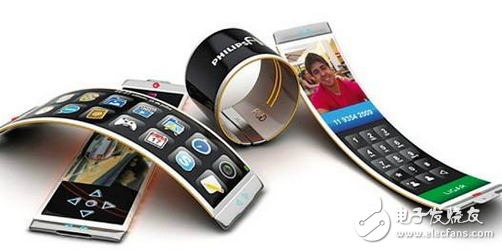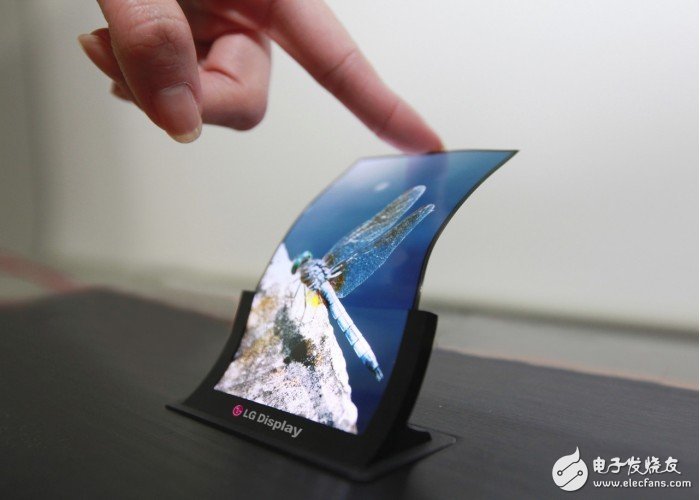Nokia's button design was once invincible in the world, and was later pulled down by Apple. Since the iPhone straight design "unified rivers and lakes", the appearance of the mobile phone screen is rarely eye-catching. However, after a long period of technical accumulation, today's mobile phone screens are finally bendable and foldable, and OLED mobile phone screens are beginning to be popular.
At major exhibitions such as CES, Samsung and LG have demonstrated their own flexible screen mobile phones with the advantages of OLED screen technology. However, products that are truly commercially available depend on large manufacturers.
Apple and Samsung are grabbing the top spot of the flexible screen mobile phone, re-developing the core or putting it on the development of the foldable mobile phone. However, domestic brands Huawei and OPPO are also developing foldable mobile phones.
A few days ago, Apple gave Samsung a super big single for the iphone8 stocking OLED panel. According to DigiTImes, the value of this two-year contract is as high as 9 billion US dollars, but after Samsung, Xiaomi, Huawei and OV joined the team's apple, In fact, there are other unfathomable strategic schemes.
Panel makers kill three countries, 3 years of empty window is the key!
In the 1990s, with the overall shrinkage of Japanese panel makers, the Korean system took the time to take the initiative and gradually took the initiative in the battle to establish OLED as the next-generation display standard.
Samsung's Samsung Display CorporaTIon (hereinafter referred to as SDC) has an unshakable advantage in active matrix-driven AMOLEDs. DSCC data shows that Samsung AMOLED shipments account for 97% of the total, which is in an absolute monopoly. LG Display (LGD), which is also a Korean company, specializes in large-size OLEDs and targets the smart TV market. However, the process, yield and longevity of large-size OLEDs are naturally flawed, despite Sony’s follow-up, Skyworth and other manufacturers accompanying them. Business is far less mature than small size OLEDs.
What makes Samsung most happy is that under the Korean attack, Japanese panel makers only left Japan Display Inc (JDI) to take the lead. The latter took the government aid to the sword and developed the liquid crystal flexible panel made of plastic material. Try to fight the trend of OLED.
The real threat is China's panel makers. In 2017, there will be more than 12 LCD panel production lines of 8.5 generations or more, especially BOE firepower, except for Hefei's 10.5-generation LCD panel production line, 5.5 generations of Ordos. AMOLED has been put into production, and the 6th generation AMOLED of Chengdu and Mianyang will also be mass-produced. Other Chinese companies such as Innolux, CLP Panda, Huike, Huaxing Optoelectronics and Tianma Microelectronics also have corresponding plans.

However, China's OLED manufacturers represented by BOE will not be able to ship in batches until 2020, and the demand for OLEDs has long been released before the tacit marketing of Samsung, LG and Apple.
In other words, the most important display technology of domestic mobile phones will be forced to rely on Korean manufacturers in the past three years! Needless to say, mobile VR devices also rely on OLED screens!
Apple is picking up the battle and trying to make a profit!
Some people think that Apple is forced to adopt OLED to soften to Samsung, which greatly underestimates Apple's wisdom. In this multi-angle struggle, Apple's performance is sleek, and Cook has three purposes for Samsung:
One is to stabilize Samsung. This year, the world's 550 million OLED production capacity is mostly controlled by Samsung. In short supply, Samsung SDC has also repeatedly cancelled orders. Google has to remove OLED from its own Daydream Ready mobile VR standard. This is the reason, Huawei flagship machine. Even the flagship did not eat Samsung's bitterness.
Therefore, Cook made a huge amount of money in advance.
The second is the domestic mobile phone with a bottom-up salary. With this year's OLED production capacity, Samsung has eaten half of its own, and the rest is all swallowed by apples. What about domestic mobile phones?
Of course, the sly Cook also left behind for Samsung.
Apple quietly added LGD, Foxconn, Sharp, BOE, and Japanese JDI to the list of suppliers in 2018. Only when its technology and capacity are mature, it can counter Samsung. It is said that Apple has secretly carried out the BOON AMOLED for several months. test. The situation of Hon Hai and Sharp is similar. Under the arrangement of Guo Taiming, Sharp set out to prepare three AMOLED production lines, one of which is a 4.5-generation line and two 6-generation lines, which can produce 59,000 AMOLED glass substrates, equivalent to monthly. Supply 9.85 million 5.5-inch AMOLED screens.
In addition, many suppliers also revealed that Apple secretly asked them to develop ultra-thin OLED panels, and required higher resolution than Samsung, indicating that it intends to strengthen the difference with Samsung panels.
Apple's strategy can be roughly summarized as the use of orders for Samsung's unreal sense of security, iphone8 is testing at least 10 models of the prototype, of which only one uses OLED screen, when Samsung's 8.9 billion US dollars expansion of OLED, Apple concealed It retains the autonomy of choice, while at the same time inhibiting the possibility of domestic mobile phones against iphone in the screen display technology.
Samsung controls production capacity and tries to control the source
Samsung, which has a bad year, is very clear about the significance of ensuring the advantages of OLED technology, especially in evaporation and packaging processes. The advantages of OLED's self-luminous, wide color gamut and contrast are that.
However, the core evaporation equipment is completely controlled by Canon's steaming machine manufacturer Tokki. Samsung's savvy order has locked Tokki's production capacity in advance, which forced Apple to place an order for LGD to delay the order. By 2018, Samsung also ensured that Chinese panel makers could not get the key equipment in two or three years. However, Tokki is determined to double the capacity of vacuum evaporation machines to 200,000 units this year, which is also a test for Samsung.
Samsung firmly agrees with DSCC's prediction that in 2021, Samsung SDC's share of the OLED market will fall from the current 97% to about 63%. Although it is still a very important manufacturer, it must be prepared.
What is certain is that Samsung will inevitably make the most use of OLED technology monopoly. The specific means include canceling or delaying the orders of domestic mobile phones such as Huawei, OV and Xiaomi, and preferentially distributing the goods to their own mobile phones and the more lucrative iphone to highlight the product positioning. The generation difference.
Samsung's space-for-time is to control the pricing power before the Chinese panel makers stabilize the supply of OLEDs, and join hands with Apple to fight the Chinese mobile phone manufacturers that threaten themselves the most.
At the same time, the flexible characteristics of OLED, wide color gamut and purer black, it is more suitable for VR equipment than LCD. The monopoly of OLED actually limits the pace of domestic mobile phones into VR.
Domestic mobile phones are difficult for three years, and the future is unpredictable
In contrast, domestic mobile phones will face great difficulties in recent years.
The first is that the annual shipments have led to the early saturation of the domestic market. The original low-price competition strategy is difficult to maintain, and the core technology has no major breakthroughs. The only good concept OLED is in the hands of Korean competing products.
Therefore, Xiaomi, OPPO, VIVO and Xiaomi have sincerely sent OLED orders to Samsung. Only OPPO and VIVO are said to have divided 13% and 10% of production capacity, plus Samsung’s own 56%. Space.
But Apple's scary big order led to a sudden change.
The domestic mobile phone knows that the production capacity won't be reliable, and they have retreated. Huawei has lowered its orders by 10%. VIVO has reduced its shipments from 130 million to 95 million this year, and the corresponding reductions have also been made. Dependence on OLED production capacity.
In the face of the attack between Apple and Samsung, Chinese manufacturers also have two counterattacks.
First, panel manufacturers have stepped up the construction of vapor deposition equipment.
Although Samsung controls Tokki's production capacity, Apple's big orders have also stimulated other Korean manufacturers to follow suit. SUNIC, YAS and SFA are all manufacturing OLED evaporation equipment for Chinese manufacturers. SFA said it has delivered 4.5 for Chinese partners. An evaporation device for OLED lines. Since May last year, SUNIC has also begun to provide large-scale evaporation equipment for LGD.
On the other hand, cooperation between domestic mobile phone manufacturers and panel manufacturers is also becoming increasingly close.
Huawei and OV's parent BBK signed an OLED alliance agreement and will continue to increase investment in LOED from this year. BBK has set up a panel company called MGV, which plans to mass produce 60,000 OLED screens per month. However, it is really necessary to fight against Samsung, and it will wait until 2020 to form a scale of production capacity of BOE, Huaxing Optoelectronics and Tianma Microelectronics.
The biggest problem at the moment is that domestic mobile phones have to spend three years of empty windows between Samsung and Apple. They watched the latter play the OLED concept and launched a variety of dazzling OLED-based mobile VR devices.
Google plans to inject LG more than trillion won to increase the flexible screen

Morning news on the 10th, South Korea's "Electronic Times" (Electronic Times) quoted an anonymous source on Monday as saying that Google has proposed to inject at least 1 trillion won (about 880 million US dollars) to help LG Electronics improve organic light-emitting diodes (OLED) The output of the screen. The newspaper said that Google's move is aimed at obtaining a stable source of OLED screen supply for its new Pixel smartphone.
It has been reported that Samsung's new Galaxy Note 8 mobile phone will use this flexible screen, Apple's iPhone 8 will also use Samsung's OLED screen.
Pond Filtration Pumps,Canister Filter,Frequency Outside Filter,Garden Pond Pressure Filter
Sensen Group Co., Ltd.  , https://www.sunsunaquariums.com
